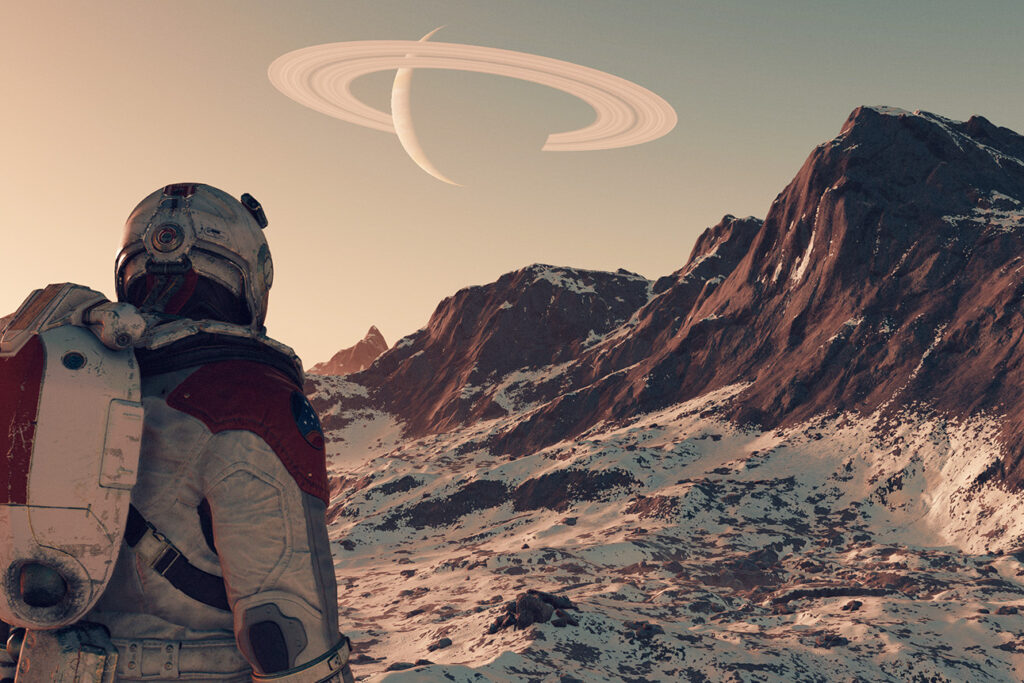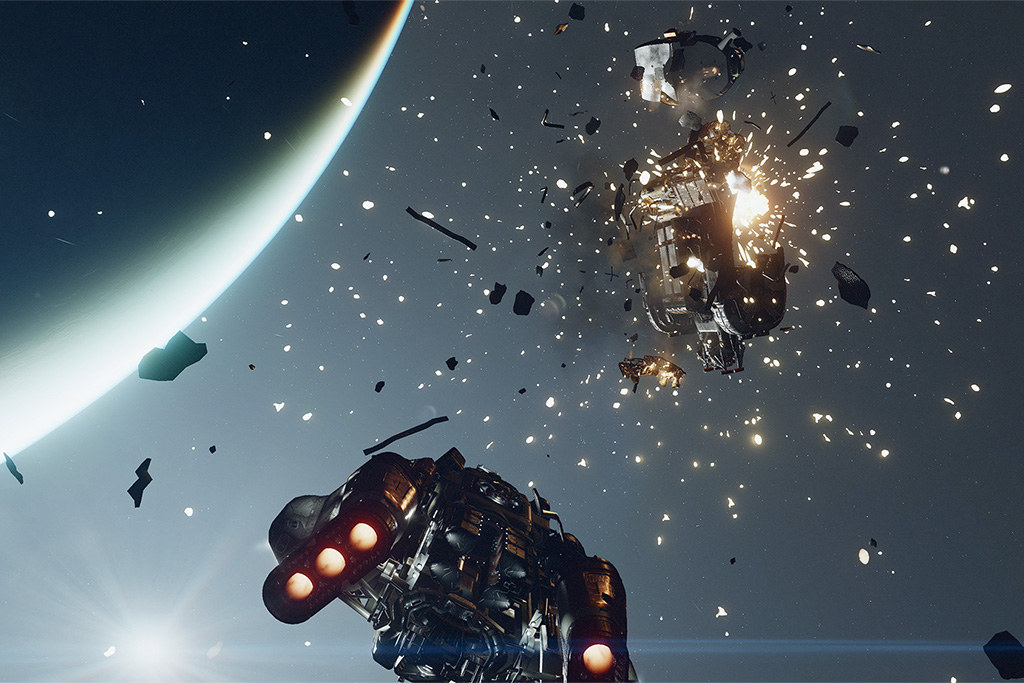Behind the scenes of Starfield, where you can explore a thousand new worlds among the stars
If you’ve ever dreamed of launching into space and exploring new worlds, a much-anticipated new video game can take you there in rich detail and immersive storytelling.
With Starfield, the first new universe from Bethesda Game Studios in 25 years, your role-playing journey can lead to more than 1,000 planets. It’s now available on Xbox Game Pass, Xbox Series X|S consoles, Windows PCs and Steam.
“We love the idea of exploring space and always wanted to turn it into a game. People love to get lost in games we build, and we do as well,” says Todd Howard, game director and executive producer of Bethesda Game Studios, which Microsoft acquired through parent company ZeniMax Media in 2021. “This one is easily the most ambitious one we’ve built. It’s something we’ve really poured ourselves into over a long period of time.”
Inside Bethesda Game Studios (BGS), known for critically acclaimed role-playing franchises like the fantasy-based Elder Scrolls and the post-apocalyptic Fallout, most of the studio staff were committed to developing Starfield. Howard says the studio trademarked the name and drafted initial concepts in 2013, then began development in earnest after the release of Fallout 4 in 2016.
The team worked for years to make Starfield an enthralling, open-ended adventure. It’s up to players to create their own unique story, changing it up to build ships and outposts, or explore at will.
“You have the agency,” Howard says. “You’re the one deciding.”
For those who are more goal-oriented in their gaming, there are storylines filled with quests and missions, such as the chance to join a group of explorers trying to find the answers to some of humanity’s biggest questions.
From the beginning, the studio’s producers knew they wanted to go big with the game, simulating not just galaxies and planets but everything on them: cultures, native wildlife, religions, mythologies, back stories, cities and characters. Players can customize almost everything in the game, from the ship they pilot to their own character, their combat style and more.
Because the game can go in whatever direction a player chooses, it can be playful, too.
“I don’t want to play the hero, but I want to go out and just start taking things from people as quickly as possible,” says producer Jamie Mallory, who likes to make her ships look like spiders and other animals as she claims other ships.
Her preferred treasure? Sandwiches. She stockpiles them in a cargo hold she’s designated specifically for this edible bounty. She also likes to use photo mode to take “rockstar photos” of exciting scenes as she explores new worlds.
“Throughout the galaxy, there are so many things to see and stories to experience,” says Rick Vicens, lead animator. “But the most important story is the one that you tell.”
It’s all designed to engage you and challenge your imagination.
“We want to give you that feeling of going where you want to go, doing what you want to do. We ended up with around 100 star systems, which felt manageable and not infinite like space,” Howard says. “It creates the right sense of scale.”
Those star systems, in turn, spawn moons and planets — about 10 in each. Among the countless adventures you can embark on are navigating through asteroid fields, meeting interesting strangers, dogfighting in space and exploring derelict ships.
Rather than setting it far off in an unrecognizable future, Bethesda opted to place Starfield in a more relatable reality, with an abundance of sci-fi influences and inspirations from Howard’s own childhood in the 1970s and ’80s making their mark throughout the game.
“There’s so much out there, but we always knew our visual tone — as far as science-fiction — was going to be more realistic, where you could draw the line from humanity going into the stars to where the game is set, as opposed to very fantastical. Though it is a video game, so we have some of that,” he says. “But it’s more grounded in how things may be.”
While it’s set in 2330 A.D., ships aren’t perfect. Your ship is your home, and it’s slightly retro and analog, lo-fi more than sci-fi with buttons and switches instead of touchscreens. Worn and lived in, it creaks when it moves. It reminds you that exploring space is a dangerous proposition.

“Our mission was to convey the wonder and majesty of space exploration, to evoke the romance of the golden age of early spaceflight. And we’ve been referring to this approach as NASA Punk,” says Istvan Pely, art director. “This means a design language where the tech is advanced, yet still looks grounded and relatable.”
And that doesn’t just apply to the ships. In Starfield, planets look and feel realistic, as do their inhabitants, wildlife, architecture and more. And each is thoroughly aligned to their particular star systems. While much of these worlds came from the creative minds at Bethesda, the team did research to stay true to that real-world feeling.
Being located close to Washington, D.C., BGS teams were able to visit and talk to local experts at the nearby National Air and Space Museum and NASA Goddard Space Flight Center. Howard also visited SpaceX in California. They talked to people with experience in space programs about possible futures and incorporated those ideas as they did their research, with some diving deep into previous space missions and highly technical documentation.
Studio Director Angela Browder, who has been on the Starfield team since its inception, says they were able to tap into internal resources, too.
“We have all these people who have these passions that are outside of video games, and because this game has so much to it, they’ve had the opportunity to share their expertise,” she says. “So many people have interesting side hobbies, whether it’s robotics, astronomy or plant life. It’s been an opportunity for people to merge multiple passions into one and be even more invested in this game.”
Browder says the team’s expertise comes through in the level of detail throughout Starfield. They tried to cover as many bases as they could, from thinking about how the sun moves on different planets to calculating lighting, to dynamically changing how characters move and react due to gravity, to the many camera angles to observe a planet, to designing habitat modules and other components of a settlement.
Browder kept everything on track and moving forward for the many teams needed to pull off all the elements of this game, which also shows off advances in lighting, animation and character generation. She says the studio’s own journey wasn’t always smooth.

“Our ambition is always our biggest obstacle,” says Howard. “It’s fun to dream up these things. Pulling off a game of this scale on its own is an obstacle in time, in people. And then the pandemic, it made everything slow down. It challenged us to communicate in new ways and work together in ways we never had before.”
But because many at the studio had worked together on other games like Elder Scrolls and Fallout, “there was a big trust level, and we were passionate about what we were doing,” he says. “So it took longer than we wanted, but we’re very excited for everyone to play the game.”
That extra time in development kept the team focused on the core experience they want players to feel – explorers breaking ground on new planets, where they’ll meet interesting people and creatures, and throughout the journey, getting sidetracked on adventures.
Like others at Bethesda, senior-level designer Zachary Wilson is as enthusiastic about playing the game as making it and keeping it true to Bethesda’s DNA of unique encounters, handcrafted quests and self-exploration through storytelling.
“We want you to feel hopeful. We want you to feel this sense of awe and wonder,” Wilson says. “And sometimes a little fear. We’re giving you a massive playground and a ton of toys and just setting you free.”
This story was originally published on Sept. 6, 2023.
